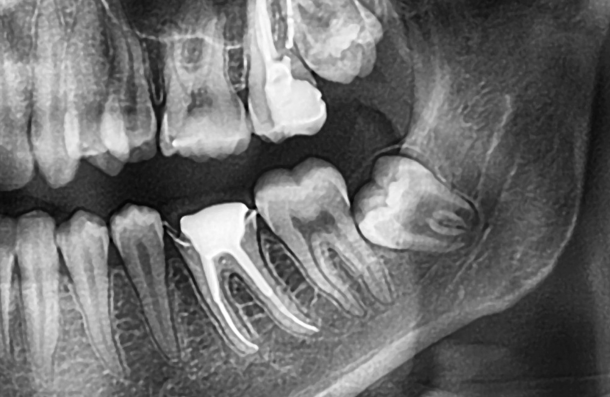Wisdom teeth extraction
- Home
- /
- Treatments
- /
- Oral surgery
- /
- Wisdom tooth extractions
A wisdom tooth or third molar is one of the three molars in human teeth which usually start to come through at the back of our gums at each corner of jaw in late teens and early twenties.
By this time, the other 28 adult teeth are usually in place, so there isn’t always enough room in the mouth for the wisdom teeth to grow properly so they may become impacted and require removal.


A wisdom tooth or third molar is one of the three molars in human teeth which usually start to come through at the back of our gums at each corner of jaw in late teens and early twenties. By this time, the other 28 adult teeth are usually in place, so there isn’t always enough room in the mouth for the wisdom teeth to grow properly so they may become impacted and require removal.
An impacted wisdom tooth happens when there isn’t enough space for it to break through the gum properly. It can become twisted, tilted, or trapped in the jaw.
There are three types of impaction:

Impacted wisdom teeth can trap food and bacteria. This build-up leads to serious dental problems, including:
Gum disease: Plaque toxins cause red, swollen, painful gums. Surrounding teeth and bone may also suffer.
Tooth decay: Plaque breaks down tooth enamel, causing cavities that can spread to other teeth.
Dental abscess: Bacterial infections lead to painful pockets of pus in your gums or wisdom teeth.
Pericoronitis: Infection in the soft tissue around the tooth, often triggered by trapped plaque.
Cellulitis: A bacterial infection spreading to the cheek, tongue, or throat.
Cysts and benign growths: Impacted teeth can cause fluid-filled swellings or cysts if left untreated.
Make an appointment with your dentist If you experience any of the following symptoms

First of all, your dentist will assess your wisdom tooth and carry out an X-ray of your mouth. This gives a clearer view of the position of your teeth in order to determine if it needs to be removed.
We may request a OPG scan, at an additional cost. This is to be completed prior to the extraction appointment to assess the full position of the tooth and its proximity to the ID nerve. This is to ensure we reduce the risk of nerve injury.
The extraction procedure will then depend on the type of impaction you have. You might need to be referred to a specialist dental surgeon at the hospital.
If the extraction is to be carried out at Abbey Mead you will be given local anaesthetic injections to numb the area so that you will only experience pressure during its removal.
Some procedures only take a few minutes, whereas others can take 20 minutes or longer depending on the complexity.
“My dentist took great care over my repair, i thought. In fact i thought that she was quite excellent”
“Very professional and caring. I’m halfway through my dental implant and have received excellent treatment.”
“I broke a tooth on Sunday evening. I rang on Monday, not expecting to be seen for weeks as I wasn't in pain. Despite the practice being shorthanded I was seen on Friday morning...”
“My first appointment was an initial inspection. The dentist was polite and friendly and very helpful in explaining what he was doing and why as well as answering my questions. The whole experience was...”
“Highly recommend, friendly receptionists, Chloe did an amazing job with the help of Theresa, great service. Thank you”
“Top-tier service and an even better team. Always look forward to coming back!”
“Agree with all previous views. Kind and reassuring advice from Richard and very friendly receptionists.”
Error: No feed with the ID 2 found.
Please go to the Instagram Feed settings page to create a feed.


